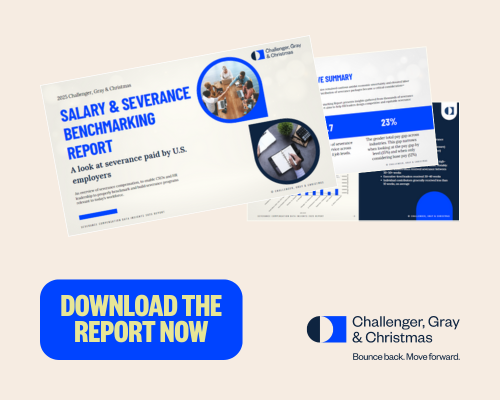
Jan 13 The Gender Severance Gap: Progress, But Not Parity
Why equitable offboarding is the next frontier in pay equity.
For years, HR leaders have been working to close the gender pay gap. But when layoffs happen, another inequity often goes unnoticed — the gender severance gap.
According to the 2025 Challenger, Gray & Christmas Severance & Salary Benchmarking Report, women received 4.6% less severance than men across all industries in 2024. Yet, in some sectors, women actually outpaced men — receiving significantly higher severance packages in industries like education (+75%), chemicals (+27.6%), and insurance (+22.5%).
The mixed picture points to progress — but not parity.
Key Takeaways:
- Women received 4.6% less severance than men on average in 2025 — though some industries reversed the trend.
- Sectors like Education, Chemicals, and Insurance favored women with higher average packages.
- The gap shows progress toward equity, but inconsistencies remain across industries.
- HR leaders can close the gap by auditing severance data by gender and level to ensure equity at every career stage.
The Hidden Side of Pay Equity
When organizations talk about “equity,” they usually mean paychecks. But what happens after a paycheck ends also matters.
Severance communicates how an employer values contributions, loyalty, and dignity in departure. A pattern of inequitable severance — even a few percentage points’ difference — signals structural issues that can undercut years of pay equity progress.
The 2025 report shows:
- The total pay gap between men and women across industries remains at 23%, narrowing to 15% by job level.
- But when looking specifically at severance, the gap is smaller — and, in some industries, even reverses.
- That shift suggests some employers are beginning to apply equity principles more consistently in exit compensation decisions.
This is encouraging — but inconsistent.
Why Severance Equity Matters
When layoffs occur, employees don’t just compare whether they got severance — they compare how much and how fairly.
A gender severance gap, even if unintentional, can:
- Erode trust among employees who expect fairness at every career stage
- Expose organizations to legal and reputational risk
- Undermine DEI commitments made publicly and internally
In contrast, companies that benchmark and analyze their severance data by gender show measurable improvements in retention, morale, and employer reputation — especially among women leaders.
As Challenger’s CEO John Challenger puts it:
“Your former people are your people. How you part ways says everything about who you are as an employer.”
Industries Leading — and Lagging — in Equity
Our analysis found striking industry differences:
- Education: Women received 75% more severance than men (19.7 weeks vs. 11.2).
- Chemicals: Women’s packages were 27.6% higher on average.
- Insurance and Automotive: Also leaned toward women, with 10–22% higher average severance.
While these are positive signs, male-dominated industries — such as manufacturing, logistics, and technology — continue to show gaps favoring men. These industries are also among those offering the lowest severance overall, amplifying inequities during layoffs.
The HR Leader’s Opportunity: Benchmark, Audit, Act
As severance becomes a more visible indicator of organizational values, HR leaders can lead the charge in closing this final equity gap.
Here’s how:
- Benchmark: Compare your severance averages by level, gender, and tenure against industry norms.
- Audit: Review recent separations for patterns or unintended disparities.
- Act: Partner with finance and legal to ensure equity principles extend to every exit decision.
When done right, severance equity isn’t just compliance — it’s culture.
Get the Full 2025 Severance & Salary Benchmarking Report
The 2025 Severance & Salary Benchmarking Report from Challenger, Gray & Christmas provides detailed insights on gender-based severance, pay gaps, and emerging HR best practices.
Download the full report here to explore the data and discover how your organization compares — and how to make equity a hallmark of every career transition.

